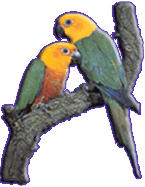|
|
| |
|
|
|
|
ALEXANDRINE PARAKEET
Psittacula Eupatria |
|
|
Photo of a bird in its full length (may be up to 1 m) |
| |
As most alexandrines, great alexandrine parakeet originate from Asia . Their habitats are India , Indochina, eastern Afghanistan , western Pakistan , Sri Lanka , Bangladesh , Andaman Islands and Thailand . This parrot species is among the biggest in family Psittacula with its size of 65 cm. Basic color is grass green. They have black stripe around the throat that makes contact with the collar that is orange-pink and located just below the nape. Collar is very easy to spot. Cheeks and nape are grey-blue. Collar starts from the black dot below the beak, on the very base of lower mandible. Wings are 22-25 cm in length. Wing coverts are darker, with grey edges. At the upper parts of the wing, below the shoulders, feathers are dotted with dashes of brown and red. Tail is 22-35 cm in length, and depends on diet and living space. Two central tail feathers are bright blue and at the end, turn to yellow. Under tail is yellow. Iris is pale yellow, with inner ring that is light blue. Beak is strong, intensive red and has 3-4 cm in length. Legs are flesh colored, and as the bird grows older, they turn into grey-yellow with strong, black claws. Female is less intense colored, she lacks collar and her tail is shorter. Older, mature birds have a ring around the pupil while the young have completely black eyes. Males get their collar in third year of life, when they become sexually mature. Color of the youngsters is also brighter, more pastel, so it is difficult to spot differences between sexes in young birds. |
| |
|
In spite of his size, it is easily tamed, and also displays great tenderness
(tamed Alexandrine takes carrot from owner's mouth)
|
| |
This bird was kept a pet from ancient times, and evidence of this could be found in literature. They were décor of many ancient roman homes. Alexandrines can live to be fifty years old if provided with proper care, food and cage. They can imitate speech, almost two hundred words, with the right training and approach. This means that in the beginning you shouldn't make sudden moves or be to close to the cage, until the bird adapts.
Female hatches 2-4 white eggs (sized 30 x 35 mm) in deep hollows and broods for 23-24 days. During that time, the male provides her with food and water. After hatching from eggs, youngsters stay in the nest for 7-8 weeks during which they get fully feathered. After leaving the nest, they stay with their parents and spend time in learning flying and climbing skills. |
| |
|
| |
Their diet consists of seedish mix: sunflower (multicolored in summer and black in wintertime), oats, millet, hemp, sorghum, corn, shelled- non-fried peanuts with addition of lots and lots of fruits and vegetables. Green salad, cabbage and pears should be avoided, meaning that they should be offered with apples, plums, walnuts, grapes, bananas, spinach, non-pealed cucumber, sweet paprika, parsley and dandelion leaves. Young birds' diet should contain a mixture of hard- boiled eggs, grinded cookies and non-grinded, blue poppy, with addition of vitamins and minerals. It is highly recommended to supply cages with fresh branches, since these birds just love to play with them, and that keeps them happy and amused instead of nervous. Branches should be from sweet cherry tree, plum tree or some other fruit tree, and in NO case from walnut tree.
The great Alexandrine is a great pet, especially for those who love big and strong birds with typical parrot-like beak. If you are persistent in taming and speaking lessons soon enough you'll have devoted and lifelong, feathery friend. |
|
|
| |
|
It should be noticed that by genetic manipulation few mutations were obtained: lutino, cobalt blue, isabel and cinnamon. This species also have four subspecies.Treba napomenuti i to da su genetskim putem dobijene sledeće mutacije, lutino, kobaltno plava, izabel i cimetna i da ova vrsta papagaja ima četiri podvrste.
I have been breeding Alexandrines successfully for years, and I must add that their parents are multiple champions of former Yugoslavia , SCG, winners of many medals both in domestic as well as in foreign expos. Following photo shows some of them: |
|
|
| |
|
|
| |
|
|
| |
|
|
|
| |
| |
|
|
|
|
|

